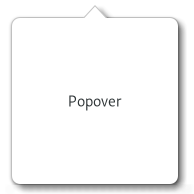Struct gtk4::Popover [−][src]
pub struct Popover(_);Expand description
Popover is a bubble-like context popup.

It is primarily meant to provide context-dependent information
or options. Popovers are attached to a parent widget. By default,
they point to the whole widget area, although this behavior can be
changed with PopoverExt::set_pointing_to().
The position of a popover relative to the widget it is attached to
can also be changed with PopoverExt::set_position()
By default, Popover performs a grab, in order to ensure input
events get redirected to it while it is shown, and also so the popover
is dismissed in the expected situations (clicks outside the popover,
or the Escape key being pressed). If no such modal behavior is desired
on a popover, PopoverExt::set_autohide() may be called on it to
tweak its behavior.
GtkPopover as menu replacement
Popover is often used to replace menus. The best was to do this
is to use the PopoverMenu subclass which supports being
populated from a GMenuModel with PopoverMenu::from_model().
<section>
<attribute name="display-hint">horizontal-buttons</attribute>
<item>
<attribute name="label">Cut</attribute>
<attribute name="action">app.cut</attribute>
<attribute name="verb-icon">edit-cut-symbolic</attribute>
</item>
<item>
<attribute name="label">Copy</attribute>
<attribute name="action">app.copy</attribute>
<attribute name="verb-icon">edit-copy-symbolic</attribute>
</item>
<item>
<attribute name="label">Paste</attribute>
<attribute name="action">app.paste</attribute>
<attribute name="verb-icon">edit-paste-symbolic</attribute>
</item>
</section>CSS nodes
popover[.menu]
├── arrow
╰── contents.background
╰── <child>The contents child node always gets the .background style class
and the popover itself gets the .menu style class if the popover
is menu-like (i.e. PopoverMenu).
Particular uses of Popover, such as touch selection popups or
magnifiers in Entry or TextView get style classes like
.touch-selection or .magnifier to differentiate from plain popovers.
When styling a popover directly, the popover node should usually not have any background. The visible part of the popover can have a shadow. To specify it in CSS, set the box-shadow of the contents node.
Note that, in order to accomplish appropriate arrow visuals, Popover
uses custom drawing for the arrow node. This makes it possible for the
arrow to change its shape dynamically, but it also limits the possibilities
of styling it using CSS. In particular, the arrow gets drawn over the
content node’s border and shadow, so they look like one shape, which
means that the border width of the content node and the arrow node should
be the same. The arrow also does not support any border shape other than
solid, no border-radius, only one border width (border-bottom-width is
used) and no box-shadow.
Implements
PopoverExt, WidgetExt, glib::ObjectExt, AccessibleExt, BuildableExt, ConstraintTargetExt, NativeExt, ShortcutManagerExt, WidgetExtManual, AccessibleExtManual
Implementations
Trait Implementations
This method returns an ordering between self and other values if one exists. Read more
This method tests less than (for self and other) and is used by the < operator. Read more
This method tests less than or equal to (for self and other) and is used by the <=
operator. Read more
This method tests greater than (for self and other) and is used by the > operator. Read more
Returns the type identifier of Self.
Auto Trait Implementations
impl RefUnwindSafe for Popover
impl UnwindSafe for Popover
Blanket Implementations
Mutably borrows from an owned value. Read more
Upcasts an object to a superclass or interface T. Read more
Upcasts an object to a reference of its superclass or interface T. Read more
Tries to downcast to a subclass or interface implementor T. Read more
Tries to downcast to a reference of its subclass or interface implementor T. Read more
Tries to cast to an object of type T. This handles upcasting, downcasting
and casting between interface and interface implementors. All checks are performed at
runtime, while downcast and upcast will do many checks at compile-time already. Read more
Tries to cast to reference to an object of type T. This handles upcasting, downcasting
and casting between interface and interface implementors. All checks are performed at
runtime, while downcast and upcast will do many checks at compile-time already. Read more
Casts to T unconditionally. Read more
Casts to &T unconditionally. Read more
Returns true if the object is an instance of (can be cast to) T.
pub fn set_property<'a, N, V>(
&self,
property_name: N,
value: V
) -> Result<(), BoolError> where
N: Into<&'a str>,
V: ToValue,
pub fn set_property_from_value<'a, N>(
&self,
property_name: N,
value: &Value
) -> Result<(), BoolError> where
N: Into<&'a str>,
pub fn set_properties_from_value(
&self,
property_values: &[(&str, Value)]
) -> Result<(), BoolError>
pub fn has_property<'a, N>(&self, property_name: N, type_: Option<Type>) -> bool where
N: Into<&'a str>,
pub fn find_property<'a, N>(&self, property_name: N) -> Option<ParamSpec> where
N: Into<&'a str>,
Safety Read more
Safety Read more
Safety Read more
Safety Read more
pub fn connect<'a, N, F>(
&self,
signal_name: N,
after: bool,
callback: F
) -> Result<SignalHandlerId, BoolError> where
N: Into<&'a str>,
F: 'static + Fn(&[Value]) -> Option<Value> + Send + Sync,
Same as connect but takes a SignalId instead of a signal name.
pub fn connect_local<'a, N, F>(
&self,
signal_name: N,
after: bool,
callback: F
) -> Result<SignalHandlerId, BoolError> where
N: Into<&'a str>,
F: 'static + Fn(&[Value]) -> Option<Value>,
Same as connect_local but takes a SignalId instead of a signal name.
pub unsafe fn connect_unsafe<'a, N, F>(
&self,
signal_name: N,
after: bool,
callback: F
) -> Result<SignalHandlerId, BoolError> where
N: Into<&'a str>,
F: Fn(&[Value]) -> Option<Value>,
Same as connect_unsafe but takes a SignalId instead of a signal name.
Emit signal by signal id.
Same as emit but takes Value for the arguments.
Emit signal by its name.
Same as emit_by_name but takes Value for the arguments.
Emit signal with details by signal id.
Same as emit_with_details but takes Value for the arguments.
pub fn connect_notify<F>(&self, name: Option<&str>, f: F) -> SignalHandlerId where
F: 'static + Fn(&T, &ParamSpec) + Send + Sync,
pub fn connect_notify_local<F>(
&self,
name: Option<&str>,
f: F
) -> SignalHandlerId where
F: 'static + Fn(&T, &ParamSpec),
pub unsafe fn connect_notify_unsafe<F>(
&self,
name: Option<&str>,
f: F
) -> SignalHandlerId where
F: Fn(&T, &ParamSpec),
pub fn bind_property<'a, O, N, M>(
&'a self,
source_property: N,
target: &'a O,
target_property: M
) -> BindingBuilder<'a> where
O: ObjectType,
N: Into<&'a str>,
M: Into<&'a str>,
Returns a SendValue clone of self.